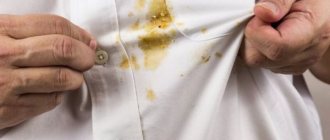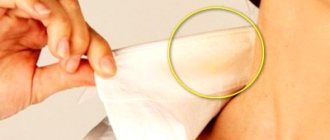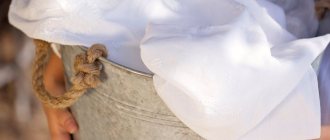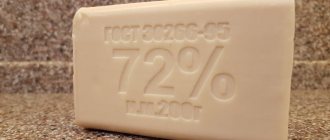A pristine white shirt always looks great. But it is with such clothes that there are the most problems in terms of preserving their whiteness.
Most often they are faced with yellowness of various origins and sweat stains. Sometimes even the best quality whitening products cannot cope with this phenomenon.
But you should not retreat, since there are many proven ways to counteract yellow spots. You can learn how to wash a white shirt from yellow sweat stains under the arms at home from this publication.
How to whiten white shirts: 10 traditional methods
Using store-bought bleaches is not always a rational decision.
Modern housewives know in practice how difficult it is to choose a bleaching agent using trial and error.
Selecting an effective substance for your home arsenal of household chemicals can be difficult for several reasons:
- high cost;
- short duration of effect;
- disappearance of a proven product from store shelves.
Modern housewives know in practice how difficult it is to choose a bleaching agent using trial and error without spoiling a single thing. Affordable and cheap materials will come to the aid of lovers of freshness and cleanliness.
Laundry soap
A solution prepared on the basis of laundry soap has been used in everyday life since time immemorial.
To combat gray color, use brown soap; there are two options for preparing a product based on it:
- Systematically collect soap residues in a glass container. First pour a small amount of water into it for quick swelling. Add liquid as soap accumulates. This option is suitable for bleaching shirts and blouses made of all types of fabric.
- Add 2 pieces of laundry soap without additives to a liter of water, after grating the soap. Leave to swell for 30-60 minutes. Place on low heat. Stir occasionally, avoid boiling the solution. Keep until completely dissolved and a homogeneous mass is obtained.
Vodka with glycerin
It is recommended to soak the item in a solution based on vodka, glycerin and water. For 1 liter of water you will need 300 ml of glycerin and 400 ml of vodka. After thoroughly mixing the ingredients, the product is soaked for half an hour in the resulting solution.
Afterwards you should wash it by hand and rub it with laundry soap. Then send the item to the machine (the mode is set in accordance with the manufacturer’s requirements). Washing is done with the addition of powder with a bleaching effect. If desired, you can add conditioner.
On a note! Using store-bought bleaches or stain removers is not always safe for items. Before using aggressive substances that promise easy removal of dirt, carefully read the tags on things and the instructions for using a particular product.
Potassium permangantsovka
The method is effective, but dangerous.
Using store-bought bleaches or stain removers is not always safe for items.
It should be used carefully, monitoring the concentration of the solution, making sure to completely dissolve the crystals in the liquid:
- Preheat the water to 75-80 °C.
- Pour manganese into water. The color of the resulting liquid should be slightly pink.
- Add washing powder (1 tablespoon of detergent per 2 liters of water).
- Soak a shirt, dress or other item made of white fabric.
- Close the basin with things tightly.
- Keep in the solution until the manganese-washing liquid cools.
- After use, pour out the potassium permanganate and rinse things 2-3 times.
Read more ► How to wash stained white or colored clothes, how to fix them
Hydroperite
To remove yellowness from linen, you can purchase hydroperite at the pharmacy. For 5 liters of water you will need 5 tablets of hydroperite (for convenience, crush them into powder) and 3 tbsp. l. washing powder. The water should be warm. Pre-soak things in this solution.
Afterwards, the blouse, dress or shirt will need to be washed and left for a quarter of an hour. Without rinsing, transfer to the drum, add bleach and washing gel. Select the mode in accordance with the fabric care requirements.
Boric acid
Many whitening products cannot always cope with their task.
Experienced housewives recommend using another pharmacy option. Add 40 ml of acid to 4 liters of water. Leave the fabric in the solution for 3 hours and rinse.
If the stain is not completely removed, spin the item again in the machine with powder or gel.
Sodium perborate
Wool clothing requires a special approach; sodium perborate is a good option for caring for it. Heat 2 liters of water to 40-45 °C, add 150 ml of product. Keep the product in the mixture for a quarter of an hour, then wash it, adding conditioner.
Vinegar
Pure vinegar cannot be used, but if you combine it with tar soap and soak clothes for an hour, the result will exceed expectations.
For the bleach you will need:
- cling film as a cover, protection against air penetration;
- 70 ml table vinegar 9%;
- 2 liters of water, heated to 30 °C.
The duration of soaking is 1 hour. After the time has passed, squeeze out, rub with soap, and spin on intensive mode in the washing machine.
On a note! Before using the chosen method of eliminating stains, it is strongly recommended to rinse the items in cold water. This will help remove dust and prevent the appearance of grayness.
Milk
Whitening using milk powder has earned the recognition of housewives. 200 g of dry product are diluted in 4 liters of water. Things are soaked in the solution for about 40-45 minutes, then washed in the usual way.
Lemon acid
Citric acid can restore the whiteness of things.
Citric acid can restore the whiteness of things . Both natural lemon juice and dry mixture will do. Before applying the acid, the contamination is wetted. Next, apply citric acid and rub in well. After waiting half an hour, the item is washed.
Soda
The product used for baking will get rid of stains on clothes and yellowing. No pre-soaking required. Simply pour equal amounts of washing powder and baking soda into the appropriate compartment and select the normal wash cycle.
The second way to remove stains is to use slaked soda and vinegar. The components taken in equal parts are applied to the fabric in the form of a foamy mass.
Features of removing stains from sweat under the arms
Many people are faced with a situation where unsightly yellow stains appear on white clothes under the arms. They are easily washed off if you do not delay washing , but do it immediately after removing the item. Just throw it in the washing machine with regular bleach powder.
But once a shirt or blouse sits for a while, it becomes difficult to get rid of stains.
If standard washing does not bring the desired result, then they resort to more effective methods using improvised means (ammonium, soda, salt, gasoline, peroxide, etc.).
Only in this case a number of important points are taken into account:
before using products based on gasoline and other aggressive inclusions, check the type of fabric;- this option is not suitable for synthetics (nylon, nylon), wool and silk, otherwise the clothes can be thrown away later;
- when washing off sweat marks, you should not use hot water (the optimal temperature is 30 ᵒC), otherwise the problem will only worsen;
- Do not use chlorine-containing bleaches or bleach - on the contrary, they make the stains even darker.
When choosing household chemicals to remove sweat stains, it is better to use oxygen-containing stain removers Vanish or Persol. The powder is diluted with water to a pasty state and applied to the armpit area, then clothes are soaked with the same Vanish and added to the washing machine when washing.
To reduce yellowness from sweat from delicate fabrics, it is recommended to make the following mixture: 15 drops of glycerin and 2-3 drops of ammonia . If it is wool, then this composition is diluted with a small amount of warm water.
Another effective substance is thiosulfate. You can buy it at a pharmacy or household chemicals department. The crystals are dissolved in warm water and applied to dirt, and then the clothes are rinsed.
How to remove yellowness from a shirt collar
Collars and cuffs require special care. They retain traces of perfume, food, liquid, sebum, dust and dirt from tables. The stains are firmly embedded in the material.
Collars and cuffs require special care
Only 4 whitening options can remove the consequences of a working day:
- Talcum powder . Contaminated areas are moistened abundantly and covered with a layer of talc. If it is heavily soiled, you need to rub it gently. Leave for 6-8 hours, wash as usual. Talc is often replaced with chalk without additives.
- The soda-vinegar mixture saves white collar faster than the previous method. The foam mass is applied to dirty places. Leave for 7-10 minutes. and wash it.
- You can also clean the stained area with citric acid Cover the stain with it for 15-20 minutes. Then wash according to the recommendations on the product label.
- laundry soap gel liberally to the surface, leave for 1-2 hours, and wash.
Read more ► How to wash towels: effective ways to bleach and clean terry materials
Household bleaches
Not everyone wants to resort to traditional methods of removing yellowness, grease stains and dirt in order to save white things. It's easier to use chemical compounds.
There is a division into chlorine-containing and oxygen-containing agents:
| Substances | pros | Minuses | Examples |
| Chlorine-containing | Quick results | Aggressive, corrode matter | "Chlorine" |
| Small quantity to use | Acrid odor, can burn mucous membranes | "White" | |
| Acceptable price | Hand and face protection required | "Domestos" | |
| Not suitable for thin materials and underwear | |||
| Oxygen | Hypoallergenic | The result is not always at a high level | "Vanish" |
| Can bleach delicate fabrics, underwear | Expensive | "Ecover" | |
| Suitable for all types of material |
Need to know! A new type of brightener has appeared - optical liquid. It visually removes dirt, the effect lasts up to 8 hours, which is enough for a working day. An example of a product is Belotex.
Why do spots appear?
Yellow stains on white clothes are formed for the following reasons:
- wash in hard water;
- incorrect choice of temperature during ironing;
- ingress of fatty substances;
- using cheap perfume;
- active sweating;
- use of unsuitable laundry detergents or aggressive bleaching agents;
- long-term storage in a room with high humidity;
- insufficient drying, after which things end up in the closet damp.
Methods for cotton fabrics
A shirt made of cotton fabric is convenient and comfortable, but dirt appears on it quickly. Problems can be eliminated by boiling or bleaching with soap or aggressive substances.
You should be more careful with “chemistry”, because... it destroys not only dirt, but also cotton.
Boiling
Applicable for shirts made of durable material. For boiling, dilute 3 tbsp in 5 liters of water. l. powder. Bring to a boil, then reduce the heat, simmer for half an hour, stirring.
Attention! Frequent boiling deforms things, so do not overuse it.
Whitening with laundry soap
Bleaching with laundry soap
This method guarantees the preservation of the shape of the cotton product. Both soap gel and the option of rubbing contaminated areas are used.
The product must be applied generously. Afterwards, put the items in a plastic bag (transparent, without a pattern) and tie it tightly so that air does not penetrate inside. Leave for up to 24 hours and rinse.
Important! Lightening of yellowed material is achieved by soaking in a mixture of hydrogen peroxide and ammonia. You can keep things to bleach in it for no more than 25-30 minutes.
Bleaching with potassium permanganate
A small strategic supply of potassium permanganate will ideally whiten white shirts. To prepare the solution you will need:
5 liters of hot water; 200 g washing powder; a few crystals of potassium permanganate (the water should turn light pink).
Place a cloth that has been pre-washed from normal stains into the mixture and tightly cover the container with a lid. Leave the shirt soaked in the solution until the mixture cools to room temperature. Rinse clothes thoroughly.
Linen clothing
Linen is easy to bleach.
It is suggested to use one of the following methods:
- To get rid of gray plaque, it is recommended to add 2 tbsp when washing. l. salt.
- To lighten, soak linen shirts and blouses in soda water. Mix 0.5 kg of soda in 5 liters of liquid. Before use, soak the solution for 24 hours and strain. This product can be stored in a glass container for a long time.
- Turpentine will help make the fabric snow-white. For 1 liter of water add 1 tbsp. l. substances. Soak things for at least 10-12 hours.
- Yellowness can be eliminated with ammonia diluted in water. To do this, add 1 tbsp to a liter of liquid. alcohol
- The last method is vinegar 9%. Pour 100 ml of vinegar into 2 liters. Soak the laundry for 3 hours and wash.
Read more ► Washing tulle to make it snow-white, choosing products, temperature and program
Important Tips
To avoid damaging your shirt during hand washing, you need to take into account the following tips:
- Before you start washing, you need to read the manufacturer's recommendations, which are indicated on the product label.
- If soaking is to be done, then only plain shirts are placed in the basin. Items of different colors are washed separately.
- After washing with bleach, the item must be rinsed thoroughly.
- It’s easier to deal with fresh dirt, so you need to start washing as early as possible, without waiting for the dirt to penetrate into the deep structures of the fabric.
- For hand washing, it is not recommended to use washing powder labeled “automatic”. Its particles are less soluble in water and produce less foam. Because of this, the quality of washing suffers.
Before the first treatment, you can test the color strength. To do this, an inconspicuous area of the shirt is moistened in warm soapy water, wrapped in a white rag and wrung out.
If colored stains remain on the fabric, the product will fade when washed.
Lightening of synthetics
Synthetic fabrics are one of the most delicate materials.
Use the following tools:
- Aspirin . For 1 shirt you need to take 2-3 tablets. Grind to a powder. Rub into damp cloth. Wash after achieving the desired result.
- Potato . Peel the tuber, cut in half. Rub the desired areas well. Wait until completely dry. Get rid of remaining starch with a brush. After such treatment, wash items in the standard way.
Removing specific stains from white items
Specific stains include traces of wine, coffee, fat, sweat, and a ballpoint pen. Don't be discouraged if you didn't manage to remove problem areas the first time.
Elimination methods for repeated and gentle use:
- wine and juice with salt and ammonia. Rub the stain, wash in ammonia water (add 1 tablespoon of ammonia per 2 liters). If you need to remove old stains, the solution should be heated to 70-80 °C.
- Chocolate is eliminated with flour and washing gel. Brew the flour (pour 1 tbsp into 200 ml of boiling water). Add 100 ml of washing gel. Leave things for 25-30 minutes. The technique is not recommended for delicate materials.
- Streaks from a ballpoint pen can be removed with vodka or medical alcohol.
- The fat is cleaned with turpentine and ammonia in a ratio of 1:2.
Good advice
With some effort, you can easily remove yellow stains from your clothes and continue wearing your favorite item.
And a few additional tips will help eliminate this annoying defect and keep the fabric fibers in their original form:
- The most suitable water temperature for removing old stains should be between 20° and 30°. Hotter water will only set the yellow color on the fabric. The only exception is clothing that is 100% cotton. Such things can even be boiled.
- Before removing yellow stains, you need to check the effect of the product used on the fabric. It is best to carry out this test on saved small scraps, which are usually attached to new clothing along with a tag. If such a flap is lost, then the check should be carried out in the most inconspicuous place. Most often, this can be done using the hem of the product, an internal seam, etc.
- Trying to remove old stains, many try to use chlorine-containing products. However, in this case, the fiber structure of the fabric very often deteriorates, and the item completely loses its appearance.
- You should never use products such as acetone or vinegar to remove stains from silk fabric. These aggressive substances will not just damage the fabric, but will burn a hole in it.
- Nylon and nylon threads dissolve under the influence of substances such as gasoline, acetone, etc.
Don't throw away your favorite white clothes if yellow stains appear on them! With a little effort and time, you can return your clothes to their original appearance.











